- Joined
- Feb 2, 2011
- Messages
- 2,286
THE AMERICAN CIVIL WAR
THE BATTLE OF BRANDY STATION, JUNE 9th, 1863
THE ARMY OF THE POTOMAC, CAVALRY CORPS.
The high ground on the farm of Richard Cunningham served as wing commander Brig. Gen. John Buford’s command post for much of the battle. Cavalry corps commander Alfred Pleasonton also observed the fighting from this area. Custer, an aide to Pleasonton was spotted here during the afternoon phase of the engagement.
Daniel Oakey was an officer in the 2nd Massachusetts Infantry, which made up Brig. Gen. Adelbert Ames’ demi-brigade that supported Pleasonton’s horse soldiers.
“Having nothing to do as yet but smoke our pipes, we lolled on the grass and studied our cavalry friends”, Oakey recalled. “Custer was the most striking of the group with…his long hair, and spirited manner. He seemed to enjoy the shelling, and appeared to beam all over, almost dancing with excitement.”
When Buford called on the Bay Staters to dislodge elements of Brig. Gen. W.H.F. “Rooney” Lee’s brigade at a stonewall at the knoll’s western base, Oakey wrote that “Custer showed much interest” in accompanying them and “evidently would have enjoyed going with us.” The young officer, however, remained behind with Pleasonton.
THE UNION ARTILLERY
The Union artillery was organized into Heavy Artillery and Field Artillery. The latter was also divided into Light Artillery and Horse Artillery.
During the Civil War the tendency was to concentrate close support at infantry or cavalry division level, with several batteries concentrated within an artillery brigade, under the command of a senior officer.
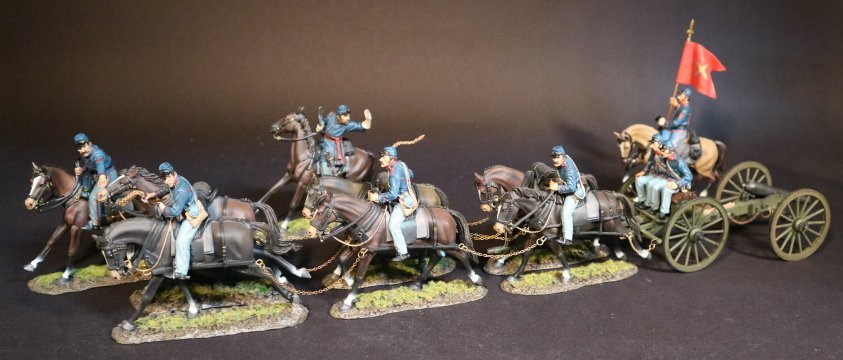
At Brandy Station, both sides had batteries of horse artillery. Confederate horse artillery, due to the South having trouble supplying horse for artillery teams as well as horses to ride, meant that Confederate batteries were standardized at four field pieces each, which was two less than their Union counterparts.
By 1863, most Union Horse Artillery Batteries consisted of six 3-in. Ordnance Rifles. These guns were comparatively light, accurate and safe.
The most technically proficient and best drilled of the arms in the Union Army was the Artillery.
Union Artillery limbers for the Field Artillery, would often be able to have 6 horse teams.
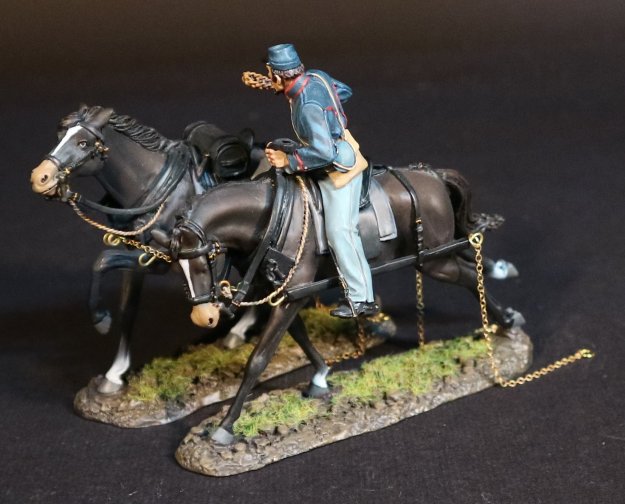
USBSA-07R
THE AMERICAN CIVIL WAR 1861 - 1865
THE BATTLE OF BRANDY STATION, JUNE 9th, 1863,
THE ARMY OF THE POTOMAC,
THE UNION ARTILLERY,
ARTILLERY CREW EXTENSION, LOOKING RIGHT
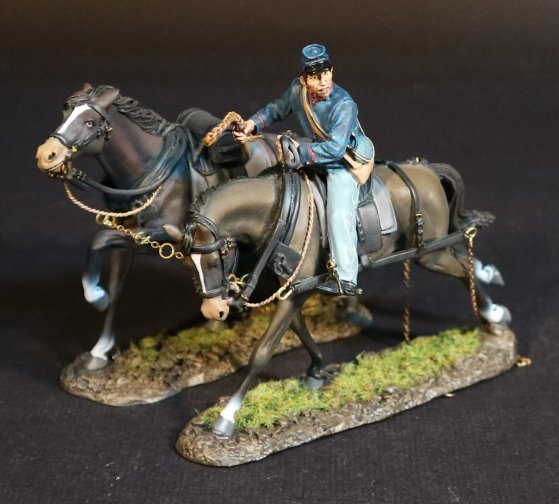
USBSA-07L
THE AMERICAN CIVIL WAR 1861 - 1865
THE BATTLE OF BRANDY STATION, JUNE 9th, 1863,
THE ARMY OF THE POTOMAC,
THE UNION ARTILLERY,
ARTILLERY CREW EXTENSION, LOOKING LEFT
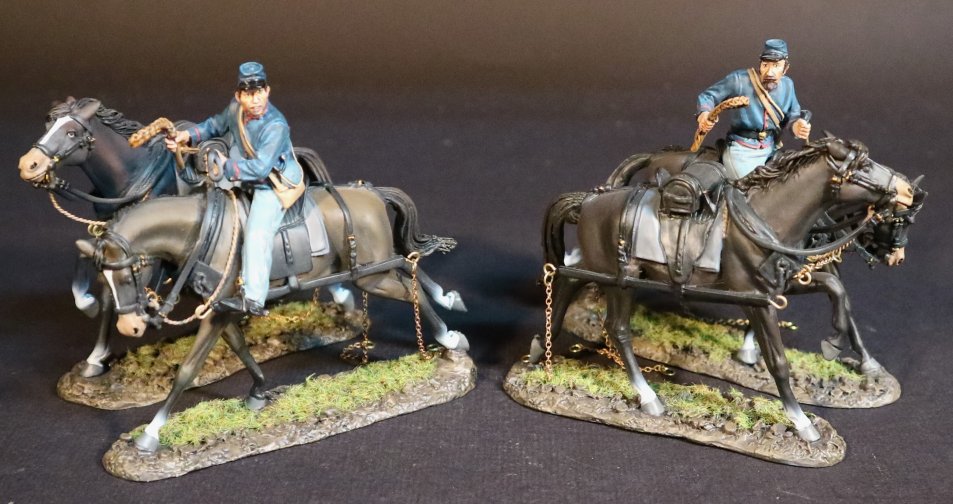
USBSA-07N2
THE AMERICAN CIVIL WAR 1861 - 1865
THE BATTLE OF BRANDY STATION, JUNE 9th, 1863,
THE ARMY OF THE POTOMAC,
THE UNION ARTILLERY,
ARTILLERY CREW EXTENSION L & R
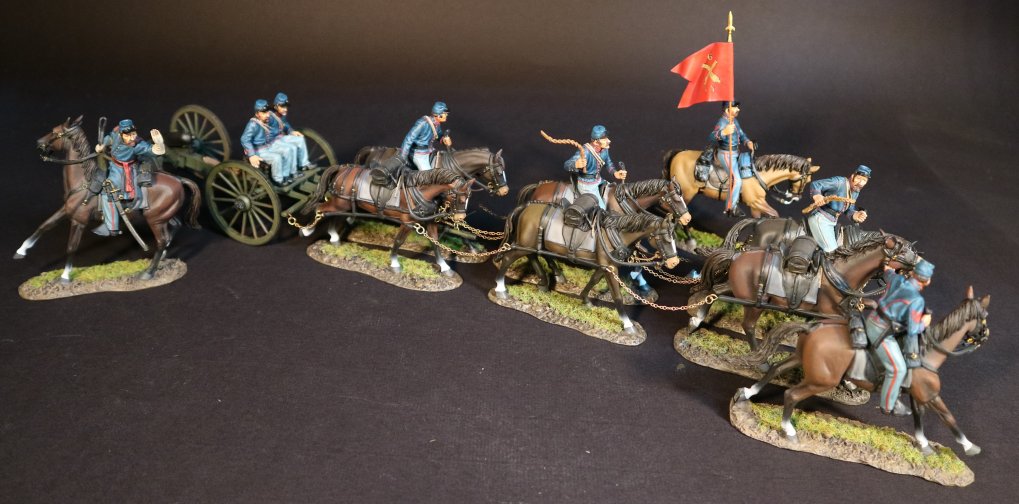
THE FIRST BATTLE OF MANASSAS, 1861
1st SPECIAL BATTALION, LOUISIANA INFANTRY (WHEAT’S TIGERS)

The battalion called the Louisiana Tigers was the creation of Roberdeau Chatham Wheat, and was to become one of the most notorious military corps ever to be raised during this conflict.
In New Orleans Wheat looked for his recruits among the Irish roustabouts and riffraff of the city.
His company was soon joined by four others and on June 9th 1861, they were mustered into the Confederate service as the 1st Louisiana Special Battalion.
The battalion soon gained a fine reputation for brawling and theft!
In action finally at the First Manassas, the Tigers showed they could also fight in battle.
An English observer wrote, “Although few in number these heroic soldiers sustained every shock with unwavering courage, and on more than one occasion dropped their rifles and rushed among the enemy with long bowie knives.”
Wheat, brave to the point of recklessness was killed 27th June 1862 at Gaines’ Mill. For the first time the battalion broke and ran. With Wheat gone there was no one to keep the Tigers in hand and on 21st August the battalion was disbanded and its men transferred to other Louisiana regiments serving in Virginia.
The name “Louisiana Tigers” however lived on to describe the Louisiana Brigade as it fought through to Appomattox.
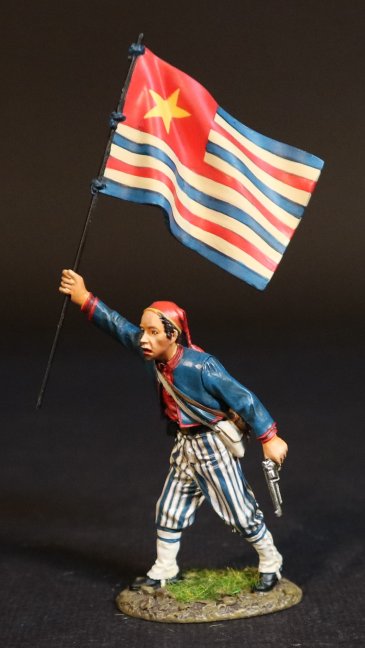
CSWT-02
THE AMERICAN CIVIL WAR 1861 - 1865
THE FIRST BATTLE OF MANASSAS, 1861
1st SPECIAL BATTALION, LOUISIANA INFANTRY,
(WHEAT’S TIGERS),
STANDARD BEARER
THE FIRST BATTLE OF BULL RUN 1861.
1st REGIMENT, RHODE ISLAND DETACHED MILITIA, 1861
In the days following the outbreak of war, Northern states scrambled to assemble small militia groups into regiment-size units, recruit additional volunteers and uniform them all in a cohesive manner. Rhode Island was no exception with the added problem of having no official state uniform for its troops. Ambrose Everett Burnside, former major general in the state’s militia, returned from his job as a N.Y. City banker and stepped up to the task of equipping and organizing the troops.

On April 20, just five days from Lincoln’s call for 75,000 troops for three months service, the First Rhode Island Detached Militia departed for Washington D.C., led by Col. Burnside himself. On July 16 the unit left camp outside the capital with the bulk of the Union Army and five days later met the Confederate forces at Manassas, Va.
With summer approaching, and expectations that the war would be short, uniforms were lightweight, with little attention to durability. Designed by Col. Burnside and inspired by the “hunting shirts” worn by many Continentals during the American Revolution, the blue flannel pullover blouse was simple and easily made by the ladies in Providence. Single breasted for line officers and enlistees, double breasted for staff.
The most distinguishing item of gear was a bright red woolen blanket. Burnside personally superintended the manufacture of the uniform,
“He had the thick scarlet blanket of each man converted into a Mexican poncho, by cutting a slit in the centre through which the head could be put, leaving the blanket resting as a cloak on the shoulders”.
A waistbelt with cartridge box and cap box, a white canvas haversack for rations and a tin canteen completed the kit.
The Regiment served in Burnside’s Brigade at First Bull Run, taking an early part in the action. For a time it stood up well, but after two or three hours of heat and combat it fell to pieces and was of little value afterwards
KADY BROWNELL
Kady Brownell was one of at least three “vivandieres” known to have been attached to this regiment.
She joined with her husband Robert, and Colonel Ambrose Burnside the regiment’s commander appointed her a Daughter of The regiment, and colour bearer.
Kady Brownell was an active participant in the First Battle of Bull Run in 1861, and at the Battle of New Bern in 1862 after she and her husband re-enlisted with the 5th Rhode Island Infantry.
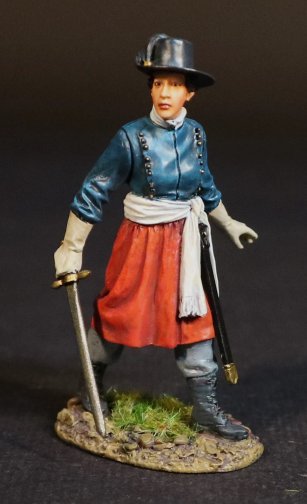
1RH-03
THE AMERICAN CIVIL WAR 1861 - 1865
THE FIRST BATTLE OF BULL RUN, 1861
1st REGIMENT, RHODE ISLAND DETACHED MILITIA, 1861
KADY BROWNELL
Contact your Dealer to Pre-Order today!
THE BATTLE OF BRANDY STATION, JUNE 9th, 1863
THE ARMY OF THE POTOMAC, CAVALRY CORPS.
The high ground on the farm of Richard Cunningham served as wing commander Brig. Gen. John Buford’s command post for much of the battle. Cavalry corps commander Alfred Pleasonton also observed the fighting from this area. Custer, an aide to Pleasonton was spotted here during the afternoon phase of the engagement.
Daniel Oakey was an officer in the 2nd Massachusetts Infantry, which made up Brig. Gen. Adelbert Ames’ demi-brigade that supported Pleasonton’s horse soldiers.
“Having nothing to do as yet but smoke our pipes, we lolled on the grass and studied our cavalry friends”, Oakey recalled. “Custer was the most striking of the group with…his long hair, and spirited manner. He seemed to enjoy the shelling, and appeared to beam all over, almost dancing with excitement.”
When Buford called on the Bay Staters to dislodge elements of Brig. Gen. W.H.F. “Rooney” Lee’s brigade at a stonewall at the knoll’s western base, Oakey wrote that “Custer showed much interest” in accompanying them and “evidently would have enjoyed going with us.” The young officer, however, remained behind with Pleasonton.
THE UNION ARTILLERY
The Union artillery was organized into Heavy Artillery and Field Artillery. The latter was also divided into Light Artillery and Horse Artillery.
During the Civil War the tendency was to concentrate close support at infantry or cavalry division level, with several batteries concentrated within an artillery brigade, under the command of a senior officer.

At Brandy Station, both sides had batteries of horse artillery. Confederate horse artillery, due to the South having trouble supplying horse for artillery teams as well as horses to ride, meant that Confederate batteries were standardized at four field pieces each, which was two less than their Union counterparts.
By 1863, most Union Horse Artillery Batteries consisted of six 3-in. Ordnance Rifles. These guns were comparatively light, accurate and safe.
The most technically proficient and best drilled of the arms in the Union Army was the Artillery.
Union Artillery limbers for the Field Artillery, would often be able to have 6 horse teams.

USBSA-07R
THE AMERICAN CIVIL WAR 1861 - 1865
THE BATTLE OF BRANDY STATION, JUNE 9th, 1863,
THE ARMY OF THE POTOMAC,
THE UNION ARTILLERY,
ARTILLERY CREW EXTENSION, LOOKING RIGHT

USBSA-07L
THE AMERICAN CIVIL WAR 1861 - 1865
THE BATTLE OF BRANDY STATION, JUNE 9th, 1863,
THE ARMY OF THE POTOMAC,
THE UNION ARTILLERY,
ARTILLERY CREW EXTENSION, LOOKING LEFT

USBSA-07N2
THE AMERICAN CIVIL WAR 1861 - 1865
THE BATTLE OF BRANDY STATION, JUNE 9th, 1863,
THE ARMY OF THE POTOMAC,
THE UNION ARTILLERY,
ARTILLERY CREW EXTENSION L & R

THE FIRST BATTLE OF MANASSAS, 1861
1st SPECIAL BATTALION, LOUISIANA INFANTRY (WHEAT’S TIGERS)

The battalion called the Louisiana Tigers was the creation of Roberdeau Chatham Wheat, and was to become one of the most notorious military corps ever to be raised during this conflict.
In New Orleans Wheat looked for his recruits among the Irish roustabouts and riffraff of the city.
His company was soon joined by four others and on June 9th 1861, they were mustered into the Confederate service as the 1st Louisiana Special Battalion.
The battalion soon gained a fine reputation for brawling and theft!
In action finally at the First Manassas, the Tigers showed they could also fight in battle.
An English observer wrote, “Although few in number these heroic soldiers sustained every shock with unwavering courage, and on more than one occasion dropped their rifles and rushed among the enemy with long bowie knives.”
Wheat, brave to the point of recklessness was killed 27th June 1862 at Gaines’ Mill. For the first time the battalion broke and ran. With Wheat gone there was no one to keep the Tigers in hand and on 21st August the battalion was disbanded and its men transferred to other Louisiana regiments serving in Virginia.
The name “Louisiana Tigers” however lived on to describe the Louisiana Brigade as it fought through to Appomattox.

CSWT-02
THE AMERICAN CIVIL WAR 1861 - 1865
THE FIRST BATTLE OF MANASSAS, 1861
1st SPECIAL BATTALION, LOUISIANA INFANTRY,
(WHEAT’S TIGERS),
STANDARD BEARER
THE FIRST BATTLE OF BULL RUN 1861.
1st REGIMENT, RHODE ISLAND DETACHED MILITIA, 1861
In the days following the outbreak of war, Northern states scrambled to assemble small militia groups into regiment-size units, recruit additional volunteers and uniform them all in a cohesive manner. Rhode Island was no exception with the added problem of having no official state uniform for its troops. Ambrose Everett Burnside, former major general in the state’s militia, returned from his job as a N.Y. City banker and stepped up to the task of equipping and organizing the troops.

On April 20, just five days from Lincoln’s call for 75,000 troops for three months service, the First Rhode Island Detached Militia departed for Washington D.C., led by Col. Burnside himself. On July 16 the unit left camp outside the capital with the bulk of the Union Army and five days later met the Confederate forces at Manassas, Va.
With summer approaching, and expectations that the war would be short, uniforms were lightweight, with little attention to durability. Designed by Col. Burnside and inspired by the “hunting shirts” worn by many Continentals during the American Revolution, the blue flannel pullover blouse was simple and easily made by the ladies in Providence. Single breasted for line officers and enlistees, double breasted for staff.
The most distinguishing item of gear was a bright red woolen blanket. Burnside personally superintended the manufacture of the uniform,
“He had the thick scarlet blanket of each man converted into a Mexican poncho, by cutting a slit in the centre through which the head could be put, leaving the blanket resting as a cloak on the shoulders”.
A waistbelt with cartridge box and cap box, a white canvas haversack for rations and a tin canteen completed the kit.
The Regiment served in Burnside’s Brigade at First Bull Run, taking an early part in the action. For a time it stood up well, but after two or three hours of heat and combat it fell to pieces and was of little value afterwards
KADY BROWNELL
Kady Brownell was one of at least three “vivandieres” known to have been attached to this regiment.
She joined with her husband Robert, and Colonel Ambrose Burnside the regiment’s commander appointed her a Daughter of The regiment, and colour bearer.
Kady Brownell was an active participant in the First Battle of Bull Run in 1861, and at the Battle of New Bern in 1862 after she and her husband re-enlisted with the 5th Rhode Island Infantry.

1RH-03
THE AMERICAN CIVIL WAR 1861 - 1865
THE FIRST BATTLE OF BULL RUN, 1861
1st REGIMENT, RHODE ISLAND DETACHED MILITIA, 1861
KADY BROWNELL
Contact your Dealer to Pre-Order today!

